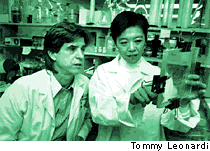Researchers at the University Medical Center have identified a major new pathological feature of Alzheimer’s disease: a plaque-like lesion involving a previously unidentified protein. It is as abundant and widespread in the brains of patients — and as specific to the disease — as the neurofibrillary tangles and amyloid plaques first described by Alois Alzheimer in 1907.

“This is a spectacular lesion, never before seen, that tracks closely with the disease state — more specifically than tangles and perhaps more specifically than amyloid plaques,” said Dr. John Q. Trojanowski, the professor of pathology and laboratory medicine who serves as director of the Alzheimer’s Disease Center at Penn. “We have every reason to suspect that this pathology will be found to play a crucial role in the development and progression of Alzheimer’s disease.” Trojanowski was the senior author on the study report, which appeared in the July issue of the American Journal of Pathology. The co-authors were Dr. Marie Louise Schmidt, Dr. Virginia M.-Y. Lee, Dr. Mark Forman, and Ting-Shan Chiu.
Others in the Alzheimer’s research community are excited as well. Dr. Zaven Khachaturian, director of the Alzheimer’s Association’s Ronald and Nancy Reagan Research Institute, said it was “potentially a very significant finding,” and could become a “central issue in our understanding of Alzheimer’s disease.” The discovery, he added, could open “fresh avenues for investigating the cause or causes of Alzheimer’s, give us a new diagnostic marker, and provide new targets for treatments.”
Considering how pervasive the plaque-like lesions are in Alzheimer’s patients — and how intensely studied the disease has been — it might seem surprising that they had not been detected before. According to co-author Lee, professor of pathology and laboratory medicine, the key was the laboratory techniques used to analyze the tissues.
“The staining and chemical-dye methods that have been used in the past to label Alzheimer’s disease pathologies — primarily silver and thioflavin staining — do not pick up this lesion,” she said. “A new series of antibodies we created to explore elements of the neurofibrillary tangles, however, did.”




